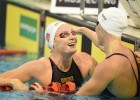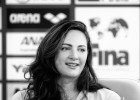

Commercial Swimming Club High Performance Coach Simon Cusack has achieved a lot over the last number of years, especially for someone who was a carpenter by trade before entering the coaching world.
Although coaching was not Cusack’s initial career focus he comes from a long line of successful coaches. His great uncle Arthur Cusack coached David Theile to Olympic gold at both the 1956 Olympics in Melbourne and the 1960 Olympics in Rome. He also coached his nephew and Simon’s father Robert to an Olympic bronze in the 4 x 100 freestyle relay at the 1968 Olympics in Mexico City.
Cusack began his coaching career in 1999 when he was asked by his father to help out at the Indoorpoopilly Swim Club for a few months. He eventually followed in his relatives’ footsteps enjoying his own success
In the last few years Cusack has been rewarded for that success winning the AIS Coach of the Year award in 2013 following that up by winning the ASCTA Coach of the Year award in 2014.
In his time with the Commercial Swimming Club Cusack has coached swimmers such as Tommaso D’Orsogna, Christian Sprenger as well as Cate Campbell and Bronte Campbell.
The two Campbell sisters have had impressive results in their careers, especially over the last three years.
Cate collected individual and relay gold at the 2013 World Championships, the 2014 Commonwealth Games and the 2014 Pan Pacific Championships. After battling injury throughout the 2015 season she won gold in the 4 x 100 freestyle relay as well as a bronze in the 100 freestyle at the World Championships in Kazan.
Bronte, the younger of the two sisters, finished behind Cate at the Commonwealth Games and Pan Pacific Championships in both the 50 and 100 freestyle. Earning a bronze and silver in Glasgow and double silver in the Gold Coast. This summer at the World Championships she had a major breakthrough winning both the 50 and 100 freestyle.
She also collected relay gold at the Commonwealth Games, Pan Pacific Championships and World Championships.
Both women have started the year with strong performances in the World Cup series.
2015-2016 LCM Women 50 Free
CAMPBELL
23.84
| 2 | Pernille BLOOM | DEN | 24.07 | 08/13 |
| 2 | Ranomi KROMOWIDJOJO | NED | 24.07 | 05/22 |
2015-2016 LCM Women 100 Free
CAMPBELL
52.06*WR
View Top 26»2 Bronte
CAMPBELLAUS 52.58 04/11 3 Penny
OLEKSIAKCAN 52.70*OR*WJR 08/11
When asked about the challenges that comes with coaching sisters who compete in the same events at the highest level Cusack told SwimSwam that he treats each of them as individuals and makes sure that they remember where swimming fits into the big picture of their lives, “I treat both girls as individuals and pitch my communication, set design and recovery strategies to cater for their particular needs,” explained Cusack.
“I try to instill in both girls that their ability to perform in the pool has no bearing on their worth as human beings. They are lucky enough to be involved in high performance sport and well supported in their role as athletes.”
“At the end of the day swimming will be just one chapter in their lives and if they reach their full potential as athletes, then it will be a well written chapter.”
Although he ensures that both athletes’ unique needs are met when asked about the differences in their preparation he expressed that there is not a lot of variation in the design, but there are in the nuances of how the plan is carried out, “There are no great differences in their preparation on paper.”
“The subtleties come around the rest and recovery. At different stages of the game one may be more robust than the other.”
So what are the differences in the strengths of Bronte and Cate?
“Bronte’s strengths lie in her sheer determination to achieve her best, her ability to enjoy racing without fear of failure and her ability to focus over the long term on whatever objective I have set for her,” said Cusack.
“Cate is a towering speed machine with great efficiency. She is also a very balanced individual and this is reflected in her personality, which makes her a pleasure to coach.”
Cusack stresses that he does not make major adjustments in his program from year to year, but that he is committed to the planned progression he has for the athletes he works with.
“No change, just a progression on last years preparation, identifying areas that need the most improvement and maintaining the great traits that had been developed over the years.”
“It is a gradual progression, like pushing on glass, and requires experience and patience. Every athlete will have a ceiling, however I try not to think too much about where that is. I like to just continue with the progression and see where the journey takes us.”
There is one specific area that they have been focusing, “Both swimmers have had considerable time dedicated to improving and finding consistency in starts and turns.”
“This is being achieved by building sufficient strength and flexibility to execute these skills and also by refining through video feedback sessions.”
Just as any athlete, both Bronte and Cate will have to continue to develop and refine their personal race strategies if they are to reach the top of the podium at the Olympic Games. This is a big part of the training plan that Cusack has desgined, “Race strategy must be developed with the athlete’s strengths first and foremost.”
“Then the coach needs to try and predict what kind of performances are likely to be successful in one or two years time at the major meet and gradually start trying to progress towards those paces through exposure to race pace training sets.”
“The end goal of preparation is to create an athlete with automaticity. One that does not have to think about race execution after the starter gun fires.”
Cusack knows that the Olympic year is unique in its demands and challenges. With the motivation level and success that the two girls have had they will have to manage those demands both in and out of the pool.
“The Olympic year is about trying to consolidate a careers worth of skill acquisition and training to be harnessed and applied in a moment in time and trying to make the least deal about the whole process.”
“Attention must be given to overtraining and adequate recovery in the daily training environment as most athletes are generally willing to train extremely hard during the Olympic year.”
“Great athletes need to be well managed away from the pool at this time also to avoid over committing to appearances and the media.”

This coach is lucky to work with two elite swimmers that are genetically very close to each other. He can hone the training system by experimenting with one swimmer keeping another one as a control group.
Good article. Insightful (though general) points by the coach. However, the Campbell sisters are natural swimmers. They have the innate size and body type/muscle twitch/strength to be at the top of the sprinting world. They are so talented in fact, that they could probably have the same results in many other programs.
No they would not necessarily have that same success in other programs . They are an eclectic family who , new to the country , were fortunate to turn up at Indooroopily & we are fortunate they chose Australia . And I want Bronte”s hair stylist .
I think genes may also have some small part in it. I seem to recall reading that their mother had been a South African champion at some point
A synchronised swimmer for South Africa iirc. This would give nice flex , lung capacity & a love of the water . Not to mention the grace they show win or lose . I want the pig also .